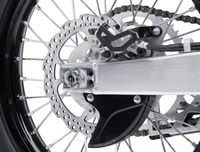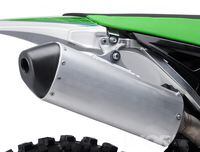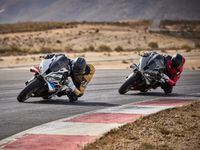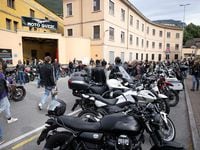This article was originally published in the February 1996 issue of Sport Rider magazine.
With a few quick strides by its mechanic, the Southwest Motorsports Harris Yamaha bursts to life like only a Grand Prix 500 can. Everyone within earshot smiles at the sound emanating from the four bulbous pipes, each pipe releasing the fury of a 125cc two-stroke cylinder. Masked but audible under the exhaust’s song is the gear whine of the V-4 engine as the mechanic’s rhythmic twisting of the right handgrip grabs and releases revs so quickly, it seems impossible. If you’ve been raised on street bikes, even the best street bikes available, this bike is a rolling impossibility. Two years ago a current nonfactory 500 GP bike didn’t exist. Now you can rent weapons like this Harris Yamaha 500 for the weekend or the season—or just buy one outright.
Mechanic Mike Rockwell continues to blip the throttle, bringing the engine temperature above the 50-degree mark, which takes several minutes due to the huge double-row aluminum masterpiece doing time as a radiator. The seat is little more than a perch, consisting of fiberglass covered with the thinnest piece of foam; it’s easy to swing into the saddle, even with the bike on its swingarm stand.
The engine continues to rev as Rockwell’s hand rotates. You bend both legs and slip your feet onto the sharp, short aluminum pegs, content to just sit and let the bike rev beneath you. With hands folded gently on the aluminum fuel tank, you review the gauges and remember that first gear is up, the rest down. And the engine revs to 12,500. At this point, nothing about the Harris is particularly shocking, but then Rockwell indicates the engine is ready. You tentatively blip the throttle on a 500 GP bike for the first time. It feels good. You put both feet down as the removal of the swingarm stand pops the rear Dunlop slick onto the ground and both your feet are flat against Willow Springs’ hot tarmac. You blip the throttle once more, and as the revs come down, you flick the clutch and notch the shifter up into first.
Like a hundred times before, you accelerate lightly down pit road, check over your right shoulder for traffic and roll onto Willow’s high-speed racing surface. Only this time you’re on a machine fully capable of setting an outright motorcycle lap record, a full-blown Grand Prix 500 developed by Harris of England in conjunction with Yamaha of Japan. This time you’re on the real thing, a pedigreed racer that spits out 160 horsepower, weighs only 260 pounds and goes like, well . . . like a 500 GP bike.
The riding position is vaguely familiar, sort of like an FZR1000 with higher pegs, and exactly like Yamaha’s limited-edition OW01. The tank is wide in front, the clip-ons severely angled and quite far apart. Your knees are spread pretty far too, but the tank doesn’t protrude into your chest as it does on an older GSXR or ZX-7. You feel perched on top of the machine rather than sitting down in it, probably due to the small sculpted tank and low fairing bubble. Despite the bike’s brutishness, the throttle and clutch move fluidly with perfectly damped motions, and you can’t believe how smooth the engine runs. Just for fun you stretch it out in fourth gear even though you’re just warming up. The power is astonishing.
The bike seems content to burble around the track all day, meting out a surprising amount of power at only 5000 or 6000 rpm. What a great street-bike engine, you think, snicking through the sweet six-speed box. At this point you haven’t tried anything aggressive, but as turn one looms, you push hard on the inside bar to initiate the turn . . . and damn near run off the inside of the track. Steering this quick seems like overkill until you remember that speed must be added before the chassis numbers really make sense. At street speed, the steering is easily as light as a CBR600’s, although the Harris takes even less effort to flop side to side; not only does it weigh 200 pounds less than an F2, but it has such extreme mass centralization that even the fuel tank is aluminum. As your lap total mounts, you struggle to meet the Harris’s demands.
Coming over turn six you leave the bike in third gear and wheelie into the back straight, stuffing the tranny in fourth as your speed exceeds the ton. Fifth and sixth gears are picked up almost immediately as the Yamaha mill spins to redline entering turn eight. The Ohlins inverted fork and piggyback shock might be capable of hoofing it through eight wide open, but a guest rider certainly is not, and the throttle gets chopped at the entrance. Despite the indelicate throttle modulation, the Harris simply tightens its line a bit and eats up turn eight’s bumps even better than Scott Russell’s Muzzy Superbike, the previous king of smoothness. As the throttle slides come up again to begin the drive to turn nine, your heart fills your mouth; nothing you’ve ridden gets between eight and nine like this. By the seventh lap you’re burying your knee in the asphalt as the reducing-radius nine approaches. Back two gears to fourth, start the drive at 8500 rpm so the power doesn’t hit too hard, then hang on for the charge up the straight. Thank God and Brembo you make turn one.
Things happen so quickly that it’s easy to get frantic because of the straight-line speed, but if you keep your head, the bike will handle whatever gets thrown at it. Panic, and you risk creating one of the most expensive balls of aluminum, titanium and carbon fiber this side of Michael Andretti’s F-1 season.
Your ride today came courtesy of Southwest Motorsports in Spring, Texas, and specifically from crew chief David Harold, tuner Bruce Maus, mechanic Mike Rockwell, team coordinator Jane Maus and rider Danny Walker. Walker’s ability on a TZ250 scored him one of the two American wild cards in the 500 USGP, and the team contacted Harris for the rental of a bike. Despite the bike’s deplorable condition when it arrived in the U.S., Walker’s team whipped the bike into shape and invited us along for its one and only test at Willow Springs just prior to the 1993 USGP.
Thanks to their hospitality, we spent as much time on the bike as Walker did, though because there were no spares available and Walker was entered in the Grand Prix the following Sunday, navigating the big Willow Springs course at speeds averaging 100 mph was a bit nerve-racking for all involved. It wasn’t until the team adjourned to the smaller Streets of Willow course that our rider could relax and truly enjoy the machine.
Cajoling 160 horsepower packed between axles only 54 inches apart to circulate a racetrack consisting of first-, second- and third-gear corners takes plenty of help from the chassis designers, and Harris's engineers certainly did the job. Engine placement, swingarm-pivot height and mass centralization work in conjunction with exact carburetion from the 36mm magnesium Mikunis to provide every opportunity to keep the front Dymag on the ground and the bike pointed in the general direction of the track. Sure, the bike wheelies at every first- and second-gear corner exit, but Walker's bike is less wheelie-prone than the Yamaha YZR500 we tested back in '91 (Motorcyclist, Oct. '91). On the big Willow track your mind is overwhelmed with the horsepower from the four-cylinder two-stroke, but on the little Willow track you have a chance to appreciate the entire package.
Keep in mind this is a small machine. Dragging a knee, flicking the bike left and right or simply changing lines midcorner takes little more than the desire to do so. It’s the timing of events that separates us mortals from Kevin Schwantz. The throttle plays a major role in every lap, not just setting all-out speed, but controlling lean angle at midcorner as well. The short Harris turns in so quickly that a dose of throttle is needed to arrest the lean angle; when the drive begins, the throttle is used to stand the bike up on the wide rear tire (the Harris wears a 6.25-inch rear Dymag wheel).
The less input at the handlebars after the turn-in, the better the bike behaves; a nervous rider hanging from the clip-ons excites all sorts of weird behavior, from head-shaking to major rear-end slides. Trust plays a major role in riding a 500 quickly because the machine does so many things so well that a first-timer simply won’t believe the performance. The brakes stop you, the engine propels you and the chassis makes sure those two events take place with as little drama as possible. As a rider, it’s your job not to goof up the combination. Get it right and you’re the fastest rider in the world. Could we have about 12,000 more laps?
More articles in the Sport Rider archive.












/cloudfront-us-east-1.images.arcpublishing.com/octane/X5TB7BDV4BA2RPSY54ZGK27RP4.jpg)
/cloudfront-us-east-1.images.arcpublishing.com/octane/REUHOJXRDBGZ5IHBYZCCBCISPA.jpg)
/cloudfront-us-east-1.images.arcpublishing.com/octane/52LGJTCKBFEHDF7S7H4CVUIMGM.jpg)
/cloudfront-us-east-1.images.arcpublishing.com/octane/YMWAIPIPSJAOXOU3QMJMGH37OM.jpg)


/cloudfront-us-east-1.images.arcpublishing.com/octane/EJ6KZRGAYBCVXNL2PJXL37UVWQ.jpg)
/cloudfront-us-east-1.images.arcpublishing.com/octane/AAN4TI76M5H5JMUVEIGASWXBDU.jpg)
/cloudfront-us-east-1.images.arcpublishing.com/octane/P3RXD2UCPFF37CMB7CHPVKXORY.jpg)
/cloudfront-us-east-1.images.arcpublishing.com/octane/VZEG2EJI2RDFZNHLRZMU56MD3Q.jpg)
/cloudfront-us-east-1.images.arcpublishing.com/octane/GVJQO5FFOFBWNGODOBRB4FBAW4.jpg)
/cloudfront-us-east-1.images.arcpublishing.com/octane/BIVAK2SFIBDJJM25E7I5VU2FJE.jpg)
/cloudfront-us-east-1.images.arcpublishing.com/octane/CH5VX52UG5CFHOVH5A6UYEFWWA.jpg)
/cloudfront-us-east-1.images.arcpublishing.com/octane/ZVGJNGZRU5C33N7KN23BBFKSC4.jpg)


/cloudfront-us-east-1.images.arcpublishing.com/octane/CZ5OM3E43ZEXJHY7LCYXCHLIKI.jpg)
/cloudfront-us-east-1.images.arcpublishing.com/octane/DF5T4K5KPZFJXFCTGPYR77PKJM.jpg)
/cloudfront-us-east-1.images.arcpublishing.com/octane/RMCT2KVQBJHBZMRTSLOVPMOILU.jpg)

/cloudfront-us-east-1.images.arcpublishing.com/octane/K45KB2XHQVA65DX7VN4ZSMT2BI.jpg)
/cloudfront-us-east-1.images.arcpublishing.com/octane/FNHXQQ56BRD7TO4YIJ453PNG2M.jpg)
/cloudfront-us-east-1.images.arcpublishing.com/octane/OIKJC4JA3ZH7BMKUGWYKBIY5FA.jpg)
/cloudfront-us-east-1.images.arcpublishing.com/octane/MT2SAEWY6FDXFBYSLDE3AEFDTM.jpg)